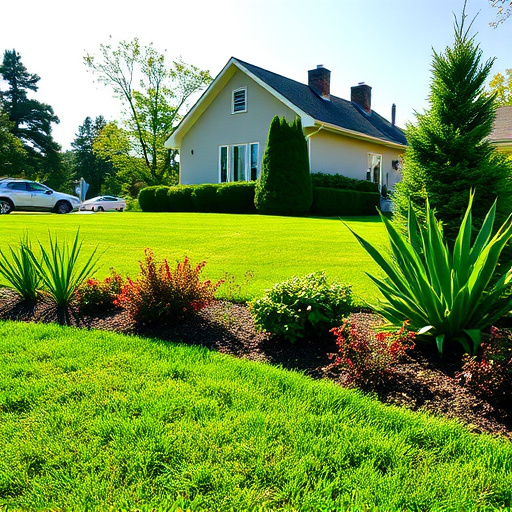Mulch and soil amendments are vital tools in lawn care and landscaping, offering moisture retention, weed suppression, and nutrient enrichment. Organic mulches like wood chips and straw gradually release nutrients, while inorganic options like rock and gravel provide long-lasting moisture control and weed prevention. The ideal mulch type depends on aesthetic preferences, climate, and plant needs. For optimal results, apply mulch evenly at 2-4 inches, leave a gap near stems, and regularly replenish it. Incorporating organic and inorganic materials ensures plants receive tailored care for healthy growth in any landscape project.
Transform your lawn care and landscaping with the power of mulching and soil amendment. This comprehensive guide explores how these simple yet effective practices can dramatically enhance plant health, improve soil structure, and encourage lush growth. From understanding the benefits and types of mulch to choosing the right amendments for diverse plant varieties, discover proven techniques to elevate your outdoor space.
- Understanding Mulch: Benefits and Types for Optimal Plant Growth
- The Role of Soil Amendments in Enhancing Nutrient Availability
- Effective Mulching Techniques for Your Lawn and Landscaping
- Choosing the Right Mulch and Amendments for Different Plant Varieties
Understanding Mulch: Benefits and Types for Optimal Plant Growth

Mulch is a vital component in lawn care and landscaping, offering numerous benefits for plant health and overall garden aesthetics. Its primary role is to retain soil moisture, suppress weeds, and regulate temperature around plants, creating an ideal environment for growth. By acting as a protective layer, mulch helps prevent water evaporation from the soil, ensuring plants receive adequate hydration, especially during dry spells.
There are various types of mulch available, each with unique properties catering to different plant needs. Organic mulches, such as wood chips and straw, improve soil fertility over time by breaking down and adding essential nutrients. In contrast, inorganic mulches like rock and gravel provide a long-lasting solution for moisture retention and weed control while not enhancing soil nutrition. The choice of mulch depends on factors like desired aesthetic effects, climate conditions, and the specific requirements of the plants in your landscape.
The Role of Soil Amendments in Enhancing Nutrient Availability

Soil amendments play a pivotal role in lawn care and landscaping, acting as catalysts to enhance nutrient availability for plants. By incorporating organic materials like compost, manure, or peat moss into the soil, these amendments enrich the earth with essential nutrients that promote robust plant growth. They help improve soil structure, enabling better water retention and aeration, which are crucial for optimal root development.
This process not only supports healthier plants but also creates a favorable environment for beneficial microorganisms to thrive. These microflora and fauna contribute to breaking down organic matter, further releasing nutrients back into the soil. As a result, lawn care and landscaping practices become more sustainable, ensuring plants receive the necessary nourishment for vibrant growth and overall ecosystem health.
Effective Mulching Techniques for Your Lawn and Landscaping

Effective Mulching Techniques for Your Lawn and Landscaping
When it comes to lawn care and landscaping, mulching is a game-changer. It involves placing a layer of organic or inorganic material on top of the soil to retain moisture, suppress weeds, and enrich the soil over time. For optimal results, consider applying mulch evenly across your lawn and landscaping areas. A consistent depth of 2-4 inches is ideal for most types of mulch, ensuring it doesn’t compact and suffocate plants. Organic mulches like wood chips, straw, or compost not only enhance aesthetics but also gradually decompose, adding essential nutrients to the soil.
In terms of application, spread mulch around the base of plants, trees, and shrubs, leaving a small gap near the stem to prevent rot. For lawns, incorporate mulch into the top layer of soil using a cultivating fork before reseeding or laying sod. Regularly replenish mulch as it decomposes, maintaining a healthy, vibrant landscape that supports robust plant growth. Effective mulching techniques are an investment in your lawn care and landscaping efforts, contributing to lush, thriving greenery over time.
Choosing the Right Mulch and Amendments for Different Plant Varieties

Selecting the appropriate mulch and soil amendments is key when it comes to lawn care and landscaping, as different plant varieties have distinct requirements. For example, organic mulches like wood chips or straw are excellent for retaining soil moisture and suppressing weeds in flower beds, while in-depth knowledge of compost and nutrient-rich amendments is vital for nourishing fruit and vegetable gardens.
When considering lawn care, a mix of organic and inorganic materials might be the best option. Organic options can improve soil structure and fertility over time, whereas inorganic mulches like stone or rubber chips offer a more durable solution to prevent weed growth and regulate soil temperature. Understanding these variations ensures plants receive the optimal care for healthy growth in any landscaping project.
Incorporating mulch and soil amendments into your lawn care and landscaping routine can significantly enhance plant health and overall garden aesthetics. By understanding the benefits of different mulches, choosing the right amendments for specific plant varieties, and employing effective application techniques, you can create an optimal growing environment. These simple yet powerful practices ensure your plants receive the necessary nutrients, moisture retention, and insulation, leading to healthier, more vibrant gardens and lawns.
